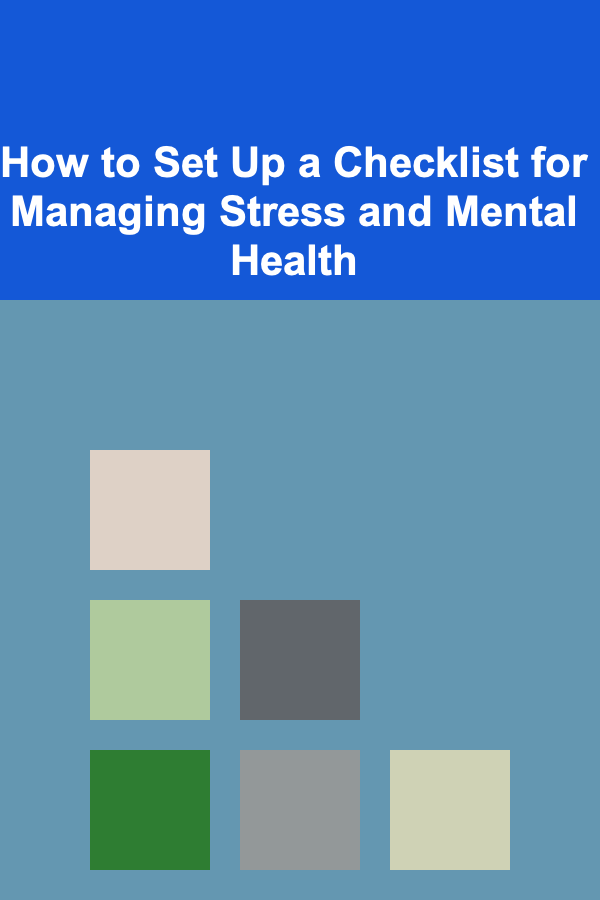
How to Set Up a Checklist for Managing Stress and Mental Health
ebook include PDF & Audio bundle (Micro Guide)
$12.99$7.99
Limited Time Offer! Order within the next:

Managing stress and maintaining good mental health are vital components of overall well-being. In today's fast-paced world, where personal and professional pressures are ever-increasing, having a structured approach to managing stress is essential. One effective way to do this is by creating a stress management checklist. This checklist serves as a daily or weekly tool to keep track of actions that help reduce stress and maintain mental health.
In this actionable guide, we will walk through the steps of creating a personalized checklist for managing stress and improving mental health. By the end of this article, you will have a clear framework to follow, whether you're looking to enhance your current self-care practices or start implementing new habits to support your mental health.
Understand Your Stress Triggers
Before creating a checklist, it's important to understand the root causes of your stress. Everyone experiences stress differently, so recognizing the specific triggers in your life is crucial to managing it effectively.
How to Identify Your Stress Triggers
- Keep a Stress Journal: For a week or two, jot down moments when you feel stressed. Note what happened before, during, and after these events. Are there recurring themes such as work pressure, relationship issues, or lack of sleep? Identifying patterns can help you understand what specifically causes you stress.
- Reflect on Emotional Responses: Notice how your body and mind respond when you feel stressed. Do you experience physical symptoms like a racing heart or muscle tension? Are you more prone to anxiety or irritability? Understanding these signs will help you recognize when you are stressed and need to take action.
Creating Your Trigger List
Once you've identified the main stressors in your life, make a list of these triggers. This will guide you in tailoring your checklist with activities and practices aimed at addressing these specific causes of stress.
Create a Daily Stress Management Routine
To proactively manage stress, it's helpful to establish a daily routine that incorporates practices designed to relax and restore your mind and body. Regular self-care is essential in preventing stress from accumulating to unhealthy levels.
Suggested Daily Practices to Include in Your Checklist
- Morning Mindfulness or Meditation (5-10 minutes): Starting your day with mindfulness exercises helps center your mind, reducing stress before it starts. Focus on your breathing or try guided meditation to cultivate a sense of calm.
- Physical Activity (20-30 minutes): Exercise is a powerful stress reliever. It releases endorphins, improves mood, and helps you relax. Whether it's yoga, a brisk walk, or a more intense workout, ensure physical movement is a part of your daily routine.
- Deep Breathing Techniques (5 minutes): When feeling overwhelmed, practice deep breathing. Breathing deeply through your nose for four counts, holding for four counts, and exhaling for four counts can activate your parasympathetic nervous system, signaling your body to relax.
- Healthy Eating Habits: Nutrition plays a role in mental health. Eating a balanced diet rich in fruits, vegetables, and proteins can stabilize blood sugar levels and prevent mood swings. Consider prepping nutritious meals or snacks ahead of time to avoid the temptation of unhealthy options during stressful moments.
- Adequate Sleep (7-9 hours): Sleep is often one of the first things compromised during stressful times, but adequate rest is crucial for mental health. A good night's sleep restores cognitive function, improves emotional regulation, and boosts resilience to stress.
Sample Daily Checklist
- [ ] Morning Meditation (5-10 minutes)
- [ ] Physical Activity (30 minutes)
- [ ] Deep Breathing Exercise (5 minutes)
- [ ] Healthy Breakfast (Include protein, fruits, and whole grains)
- [ ] Drink Water Regularly (Aim for 8 cups a day)
- [ ] Sleep Hygiene (Avoid screens 30 minutes before bed, practice relaxing bedtime routine)
Set Boundaries for Stress Reduction
Learning to say no and setting healthy boundaries is essential in preventing stress. Often, we take on too many responsibilities, leading to burnout. Setting clear limits on what you can and cannot do can significantly reduce mental strain.
How to Set Boundaries
- Identify Overcommitment: Look at your calendar and notice areas where you are overbooked. Are you saying yes to every request or invitation? Evaluate whether the additional commitments are aligned with your priorities or if they are causing unnecessary stress.
- Communicate Clearly: When you need to say no, do so clearly and respectfully. Set limits with colleagues, friends, and family to ensure your emotional and mental health aren't compromised.
- Prioritize: Make a list of the most important tasks and let go of non-essential ones. Delegate where possible, and ensure that you're only focusing on tasks that align with your goals or values.
Checklist for Setting Boundaries
- [ ] Review Calendar for Overcommitment
- [ ] Identify Tasks I Can Delegate
- [ ] Politely Decline Non-Essential Requests
- [ ] Allocate Time for Self-Care (e.g., downtime, hobbies)
Practice Cognitive Behavioral Techniques
Cognitive Behavioral Therapy (CBT) techniques can be extremely useful for reducing stress by helping you reframe negative thought patterns. This involves recognizing irrational thoughts and replacing them with more balanced, realistic thinking.
Cognitive Behavioral Techniques for Stress Management
- Challenge Negative Thoughts: When you feel stressed, ask yourself whether your thoughts are exaggerated or unrealistic. Are you catastrophizing or assuming the worst outcome? Replace those thoughts with more grounded and rational perspectives.
- Reframe Stressful Situations: Instead of seeing stressors as overwhelming, reframe them as challenges that can be overcome. For example, view a tight deadline as an opportunity to showcase your time-management skills rather than something to fear.
- Positive Affirmations: Practice positive self-talk. Repeating affirmations like "I am capable," "I can handle this," or "This too shall pass" can build resilience and combat negative thought patterns that amplify stress.
Checklist for CBT Techniques
- [ ] Identify Negative Thought Patterns
- [ ] Challenge and Reframe Irrational Thoughts
- [ ] Use Positive Affirmations Throughout the Day
Establish Social Support
Humans are social creatures, and having a support network is essential for managing stress. Connecting with others provides emotional support, perspective, and the chance to vent, all of which help reduce stress.
How to Build Your Social Support Network
- Reach Out to Friends or Family: Make time for regular interactions with close friends or family members. A simple phone call or coffee date can be incredibly therapeutic.
- Join a Support Group or Community: Whether online or in person, consider joining a group where you can share your experiences with others who understand your challenges. This can provide emotional relief and new coping strategies.
- Set Boundaries with Toxic Relationships: Not all relationships are supportive, and sometimes stress is caused by toxic people in our lives. It's important to recognize when a relationship is adding to your stress and take steps to protect yourself emotionally.
Social Support Checklist
- [ ] Schedule a Call or Meet-Up with a Friend/Family Member
- [ ] Join a Support Group or Community
- [ ] Set Boundaries with Toxic Relationships
Regularly Assess Your Stress Levels
Managing stress isn't a one-time task---it's a continuous process. Regularly assessing your stress levels can help you stay on track with your mental health management and identify areas where you need to adjust your approach.
How to Assess Your Stress Levels
- Self-Reflection: Take time each week to reflect on how you've been feeling. Are you experiencing more stress than usual? Do you notice any physical symptoms of stress, like headaches, irritability, or trouble sleeping?
- Track Your Progress: Keep a log of your stress-management activities and how they make you feel. This will help you identify which strategies are most effective and which might need to be adjusted.
Stress Assessment Checklist
- [ ] Reflect on Stress Levels This Week
- [ ] Log Activities That Helped Reduce Stress
- [ ] Identify Areas for Improvement
Seek Professional Help When Needed
While self-care techniques can be highly effective in managing stress, there are times when professional help may be necessary. If you find that your stress is overwhelming or persistent, seeking the guidance of a therapist or counselor can provide additional support.
When to Seek Help
- Persistent Stress: If you feel constantly overwhelmed or unable to cope despite trying various strategies.
- Physical Symptoms: If stress is manifesting physically in ways that affect your health (e.g., chronic headaches, insomnia, stomach issues).
- Emotional Struggles: If you experience prolonged feelings of sadness, anxiety, or irritability that interfere with your daily life.
Checklist for Seeking Professional Help
- [ ] Evaluate Whether Stress Is Persisting
- [ ] Look Into Therapy or Counseling Options
- [ ] Consider Support for Stress-Related Physical Symptoms
Conclusion
Creating a checklist for managing stress and mental health is an ongoing practice that requires regular reflection, consistency, and self-compassion. By identifying your stress triggers, establishing a daily routine, setting healthy boundaries, and incorporating proven techniques for stress management, you can build a strong foundation for mental well-being. Remember that stress management is not a one-size-fits-all approach. It's essential to tailor your checklist to your unique needs and circumstances, and don't hesitate to seek professional help when necessary. With time and practice, managing stress can become a natural and effective part of your everyday life.
Other Products

How to Build a Sustainable Investment Portfolio
Read More
How to Maintain Your Pet's Health with Regular Vet Visits
Read More
How to Organize Your Favorite Recipes for Quick Cooking
Read More
How to Plan for a Stress-Free Home Renovation
Read More
How to Set Up a Home Gym with Smart Storage Solutions
Read More